Musings

Today was designated Abbey Day in our itinerary. It was not wrong. What we really did that was most important was get to…Scotland! (And, yes, mostly we had a rainy day.)
Historically, as today, there’s a sociopolitical core to the north and south on this great island, and somewhere on the lands between has been a border zone. Today, the border’s an agreed-upon line across the landscape. For generations, it was a wide swath of contention. The border was generally porous, often dangerous, and yet had economic potential in an agrarian economy. And, land, after all, is land, and land is territory.
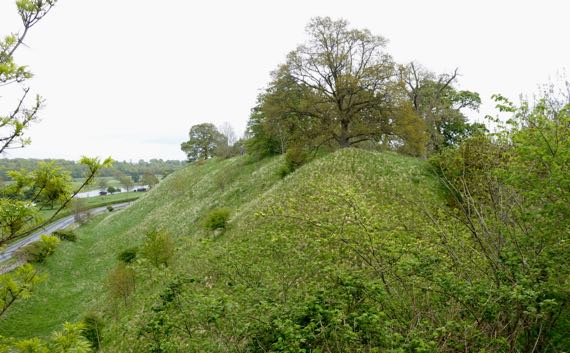
From the 1100s–1400s, a castle on this hill, between two rivers, was a political and economic center. Kings lived here, and both the northern and southern sides held it in repeated succession cycles. This was Roxburgh Castle, founded in the mid-1100s by David I, King of the Scots from 1124 until his death in 1153. Now, at the foot of this rough double-hill, there’s a small layby with room for maybe four vehicles, and no signage.
King Henry I (coronated 1100, died 1135; fourth son of William the Conqueror, King of Normandy) held sway in England, but suffered from pressures brought by rulers on the continent, in Normandy and elsewhere on the northern rim.
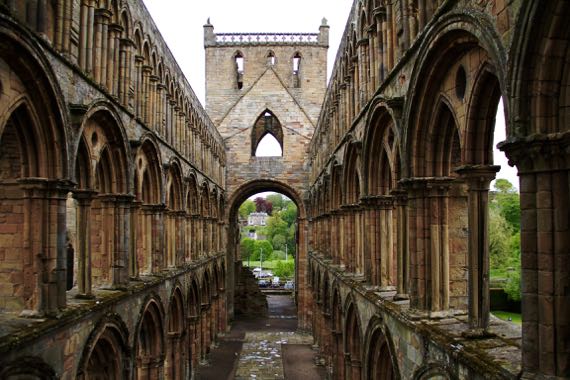
The economic and political elite of the time included both nobility and the guys who controlled large abbeys-and-churches. They were two sides of the leadership coin. Yet, the petty kingdoms of the time rarely could dominate the peripheries for long. Accordingly, cagey religious leaders were happy to build and run Jedburgh (above) and several other abbeys not far from the Roxburgh core that for centuries held sway in the borderlands—and to feed off and accept the wealth of the nobility as donations to fund repeated monk-prayers (see how well it worked, the buildings of…almost…all are now in ruins). The leadership of some of these abbeys came from afar, others from Lindisfarne….

Into this general pattern of upheaval over the centuries, the place I found most interesting that we visited relates to my family history…. Traced through my mother’s father’s mother’s ancestors, we get back, after something like a dozen generations, to the Livingstons of Ancrum, post-Reformation (them, post-Dissolution) men of god here. The original Christian outpost here was established by David I, and it became a parish church after the Reformation in 1560. John Livingston became the minister here in 1648. Some of his relations migrated to the New World in the later 1600s, including signer of the Declaration of Independence for New York Philip Livingston (1716–1778). Anyway, (somewhat tenuous) family ties to the village of Ancrum (pop. ~300). In older times, the town center was west of the modern town center, near the ruined church, now surrounded by (mostly) 19th- and 20th-C headstones, and across the river from the ruins of a flax mill….
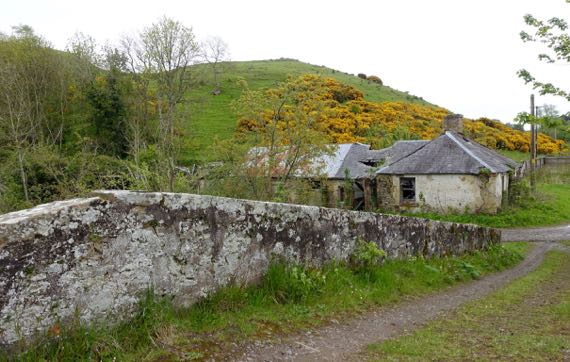
The icing on the cake…across that bridge by the church-cemetery, and up on the hill that has yellow blooms on the woody shrubs, are the remains of an Iron Age ring fort!
Posted at 10:22 PM |
Comments Off on From kings to peasants, via local leaders
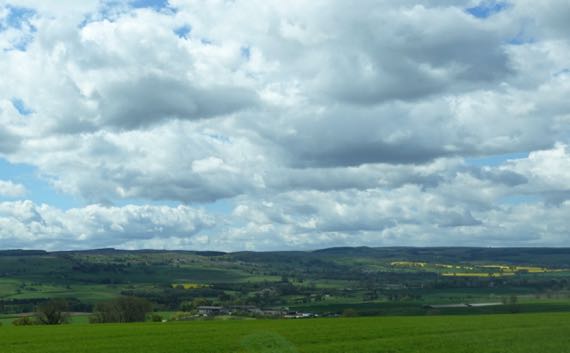
We saw the landscape change today, first as we drove north, eventually through the Pennines, and then as we drove east, descending the Tyne drainage. We saw more critters than people throughout most of it, I daresay.

We watched the row crops yield to pasture, with fields defined almost exclusively by stone walls.
We did this in Our New Car!! Yes, new to us, but ALSO it had 40-some miles on it when The Guru received the keys! New car smell! Shiny white!

The rolling countryside became treeless….
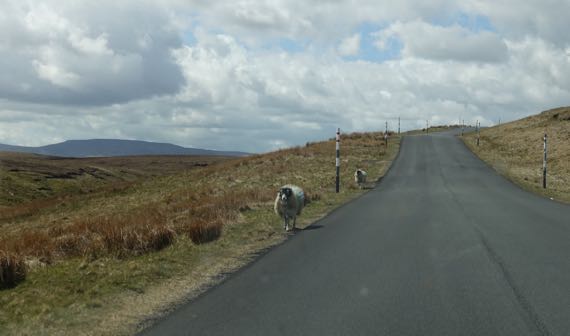
And we were on the open range, driving between the snow-sticks, and watching for “LAMBSONROAD.”

Even more exhilarating, we visited a Roman fort…. That’s the land of the barbarians on the left, and down at the bottom of the hill…the creek…that’s Knag Burn. Burns are creeks. Other things, too…. Many of the trees in this area were pine plantations, and some were newly logged, but not these “forests.”
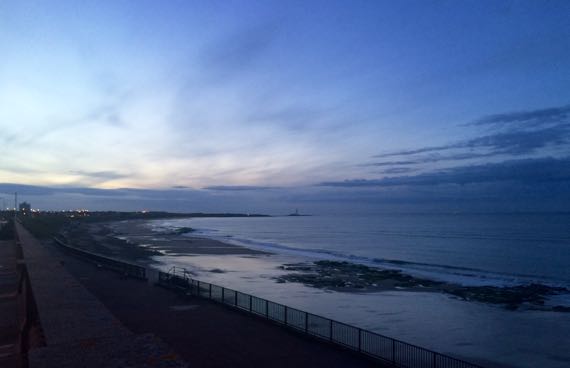
Our east leg took us to the end of the wall/road, and we watched the afterglow on a North Sea seawall.
Technical report: we’ve been using Goog__Maps to do our navigation, with Miss Voice turned on. She mentions nearly every roundabout, even the ones that are just a big white dot in the middle of a circle of pavement. Keeping us on our toes. Every once in a while she skips one, but our route is obvious. Sometimes she over-narrates curves and turns. Today she totally skipped one, and we had to backtrack. I think it was a new subdivision that wasn’t there in her world, although it was on the map. Still, using technology makes the whole process quite smooth compared to scrutinizing printed maps…without the magic blue dot of self-ness (as in, I am here, right HERE, therefore I exist…).
Posted at 10:22 PM |
1 Comment »

I’m not sure how this…crest…was used, but I find the dragon-lion claw-displaying the spoked wheel just plain odd. Anyway, today we saw many locomotives, train cars, and railroad artifacts. Room after room of them. Fix-it areas. Curation zones with rack after rack of…everything from porcelain dinner sets to chairs to uniform insignia to station signs and model engines and cars of all sizes, plus we found an outdoor viewing platform for real trains on real tracks headed to local and distant destinations. This is the short version of what you can see at the National Railway Museum in York….

Two huge warehouse-display areas featured polished, clean “locos” and carriages. And one had a turntable, and we saw the demo, done by knowledgeable young women wearing “Explainers” on their uniform backs. We discovered that as we walked around the turntable that the reverb from the sound system varied. This was a good spot, but the man fondling his lady could have been distracting.

This was an early carriage. It was a clever merging of three horse-carriage units into one train-carriage. These were low-roofed and made for seating. There was no dining area, and precious little space for baggage. The driver sat on that ledge on the outside left. Think stagecoaches in the Westerns you have seen….
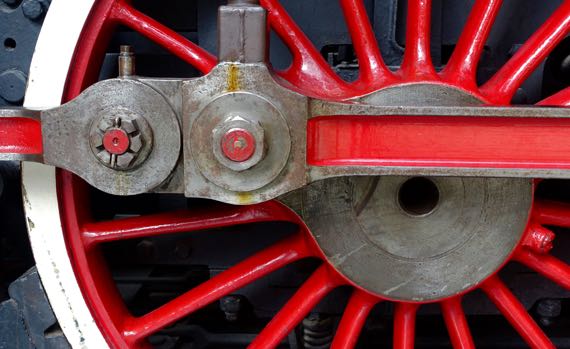
I will spare you the many closeups I took, but being able to see the mechanical parts that move the energy from up-down to around-and-around…I found it humbling in a strange I-grew-up-near-Detroit way.

Jokesters take the reins every once in a while around here…. This is the sign for the library. The library was closed, but the fire extinguisher was getting its annual checkup.
Richard Trevithick adapted steam engines to use high-pressure, and thus be more powerful. Some were built to be stationary. Others were used for railways. He is credited with the first steam rail transport in 1804. If I have it right….
Posted at 12:21 PM |
Comments Off on Trevithick’s legacy

The whole city wall thing seems like it’s from another age. And that is true of this one…it’s the current incarnation of York’s Medieval wall. This view is west, toward Micklegate Bar. Gatehouses are called bars here. And –gate in Micklegate is from the Norse for main as in Main Street. This version of the wall dates to about 15 decades ago, when the parapet wall was added to make strollers feel safer. Notes Simon Mattam for The Friends of York Walls (p12 of the 24.04.2014 version of “On the Walls—A Guide to York’s City Walls Trail”):
The Romans started York around 71 AD. They built walls around their fort and then around the city that grew up on the other side of the River Ouse. Big bits of the walls of the Roman fort can still be seen and up to half of the rest are in the ramparts under the present walls. [Four hundred] years later there were new invasions: Anglian York developed, then Viking York in the 9th century, then Norman York in the 11th century; over this time the Roman walls fell but ramparts grew.
About 900 years ago, the times we call “the Middle Ages” began—these were when the present Walls were built—mainly to protect York against the Scots. Around 500 years ago the Middle Ages ended and cannon were making military walls less useful; in spite of this the Walls were strengthened in the 1640s for the English Civil War. The Walls were seriously attacked and damaged in this war of King against parliament—but luckily a conditional surrender of the city stopped the damage and the parliamentarian victors arranged their speedy repair.
About 200 years ago there was another sort of battle being fought in York—over whether the Walls should be knocked down to open up the city to traffic and fresh air. During Victorian times a compromise developed: small bits of wall were demolished and new arches were built through the Walls but most of the Walls were repaired and opened as a footpath.
Thick stone defensive walls make me think of castles, at least in this part of the world. And there’s one that survives here, not large at all, crowning a human-made, steep-sided hill. It’s called Clifford’s Tower. Actually, this surviving architecture became the keep of York Castle.
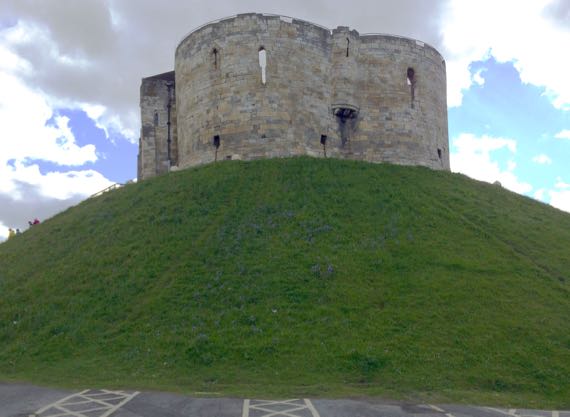
The first castle of York dates to the time of William the Conquerer, in 1068. King John of the Magna Carta stayed here…. Later, in the mid-13th-C Henry III had this version built, in a style that resembles French castles of the time. Its quatrefoil plan is very unusual in Britain. The castle was surrounded by a moat that is long gone. Its land connection was via another moated, walled area, that housed many support functions for the keep.

In those days, the interior was roofed over, with two floors. The squarish holes are where the ends of the beams that held the upper floor were seated. Contained in the wall above the entrance gate is a room that’s beneath the small roof that peeks above the wall in this view. When the portcullis was raised, it went into that room.

The other function of that room in those days was as a chapel. The room was repurposed multiple times, but the fancy carvings that framed the old window openings remain, battered and mute.

Okay. Food. I often get requests for food pictures. Brit-food isn’t…or usually isn’t…terribly well regarded. I have many photos of Full English Breakfasts, which is the most British “dish” we normally eat. Both of us are getting tired of tomato-y beans (called Beanz by Heinz in the canned version). Also, fish and chips (had this once, in Hastings) isn’t particularly pretty.
So, instead: dessert! We found this Belgian chocolate cake, lightly heated, with vanilla ice cream from a local creamery, divine. And I spooned away with a view of the sunlit façade of York Minster…really special. We are very lucky.
Posted at 3:08 PM |
Comments Off on (Not new) York

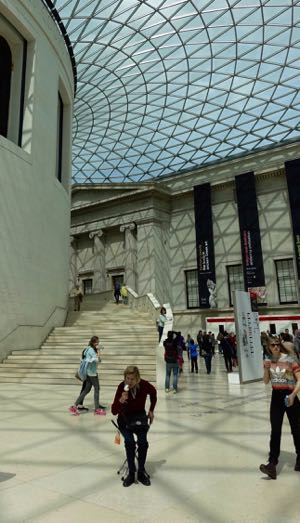
Above is our view from a room that used to be part of the B&B’s family’s compound. When we were here last many years ago, they had gotten a new but short-term lease to continue with the property, but the handwriting was on the wall that they were not going to be able to continue. I think the B&B is now managed by a face-less company, and all the staff we’ve seen are immigrants (which is fine). I’m guessing the property owner (the Duke of I forget what) has upped his income significantly. It’s all impersonal now, no one to share a cup of tea with, and no one to ask if you slept well.
This is the way of the world. I hope that family is okay; they were very nice people.
Anyway, our room is in the basement, but in the back of the building, and so facing the back garden. We hear the birds. Also using our airshaft are windows from the kitchen. This morning we heard the chatter of the young Eastern-European? women who do breakfast, starting shortly after 6am. Since we’re jet-lagged, we fell back asleep. However, after the cleanup after breakfast service, the airshaft is ours again, and this is the view. We try to avoid flashing our neighbors when we’re changing.
We had two big missions today, beyond having fun, and that’s on the list everyday! The first mission was to the BBC building, and that’s someone else’s story.


The second was to the British Museum. It’s free and busy busy on Sundays. We joined the crowds coming in the gate, through the photo-zone, and up the stairs into the building. Then, we discovered that the interior courtyard now has a glass roof, which we thought must have been a move inspired by the IM Pei Pyramide du Louvre.
I loved noticing this woman (above right), who set up her cane-chair right at the shadow junction to settle in and enjoy her ice-cream cone. I could not decide if it was a deliberate siting…. I also love this courtyard!
As a result of our crowd-avoidance strategy, we didn’t visit the treasured pieces in the collection that are on display and most discussed. No Parthenon sculptures. No Rosetta Stone.
We did look at the Etruscan room. We saw some Greek and Roman sculptures…. Cute butt, eh?

This is a close-up of one of the scenes on the side of the Portland Vase. I never would have sought out this piece, but I enjoyed “finding” it. It’s made like a cameo, in that the vase was made with two layers of glass, the inner dark one and the outer white one. Somehow, craftsmen or a craftsperson carved away much of the white, leaving this scene. I don’t know how someone carves glass successfully, but apparently it involves a gem-cutter’s skills, and modern craftsmen have found it quite a challenge. The Wedgwood company and others made copies or “inspired by” vases.
Apparently this vessel was bought by the British Museum after it was slightly damaged (fire sale price?). Then, in its care, the vase suffered mightily and was broken into many pieces. The restoration was…lacking, and in the late 1980s it was taken apart, cleaned, and reassembled using modern adhesives. Big story on the Museum website.
Posted at 4:15 PM |
Comments Off on London tales

English Heritage (we’re among its newest members) has reorganized access to Stonehenge. One reason this was sorely needed is that the cruise ships dock at Southampton, and passengers are bused to Stonehenge, about an hour each way. So the normal flux of tourists is augmented by rafts of these strange birds….
There’s now a fantastic visitor centre and bus transfer setup to move visitors from a safe distance away for parking and congesting to hobbling distance from the stones. This centre opened in December 2013 (not present on Google satellite view last time I checked), such a change from our 1989 visit. They’ve also channeled foot traffic to a track around the stones that keeps people away from them, yet allows us to see all sides. There’s even a little bridge across the Avenue where it comes into the henge, to better preserve that important feature (postulated to be the main access route). Compare this to the imperiled preservation situation in 1877….
These things do change….

Next to the visitor centre is this display of a life-size model of one of the monster stones that folks moved for many miles to make the stone circles, along with a postulated roller-method for moving the stones along the ground surface. I guess that this is a model explains the solar panel in the top (not shown; yes! seriously!).
I especially liked the room-in-the-round display in the exhibition hall that showed the stone circle viewed from the center, with the sun and stars changing through the annual cycle. I also really liked talking to the archaeologists and having the opportunity to hold real artifacts from Stonehenge, and even a reconstructed Neolithic pot (pieces of a base and some side-wall, all glued together). Loved it!
This ritual landscape is complex and was added to and altered over time. Researchers are still finding new components. Here’s some idea of what’s been recorded. All those green dots are barrows—where someone was buried. This ritual landscape extends north beyond Avebury. Stonehenge and Avebury are over 20 miles apart, as the crow flies.
By the miracle of the internal combustion engine (and I don’t know what other energy sources), we shifted our geographic point of view to the former Londinium. Kinda hard to avoid the Thames and even the Eye.
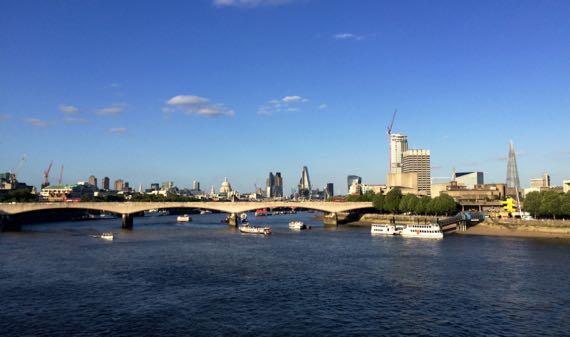
We sat and watched the water traffic and talked about how much wider the Thames is than the Seine in Paris, or, ahem, the Tiber in Rome. A real contrast. Of course, the Thames is tidal at London, and the others are not.
Posted at 5:50 PM |
3 Comments »
Here are your choices: “Soft verges,””Weak bridges,” or “No fly tipping.”
“Soft verges,” as you might guess, refers to the condition of the margin along the blacktop (ahem, macadam) of a road, when that margin is unpaved and ungraveled, and, when it’s been raining recently, like now, muddy, or liable to be muddy, even if it’s grass-covered. So, beware soft verges!
“Weak bridges” is info for drivers. It’s left up to you what to do with that knowledge. As near as we can tell, weak bridges may be…unsafe under heavy vehicles. Note the difference between this notification strategy and one where the sign says, for example, “no vehicles over 30,000 lbs,” or similar. The positon taken by the highway department is quite different….
I’ll let you continue to ponder the last one: “No fly tipping.”
Or perhaps you are more worldly than I, and KNOW what it means….
On to some stories for now….
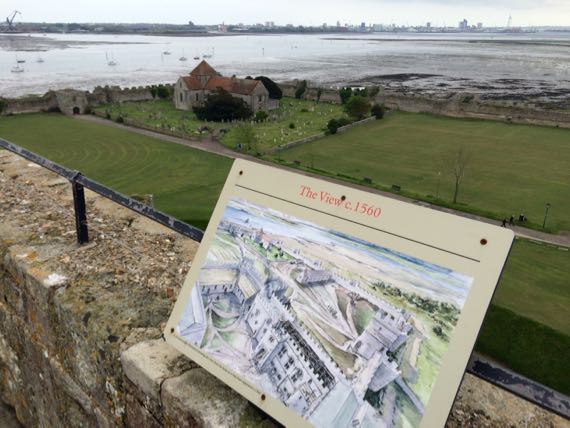
This is a view from the substantially complete keep tower from a 12th-century castle…built inside the walls of a ca. late AD 200s Roman fort. Yes, these are the best-condition walls for a Roman fort standing today. In an odd twist of fate, the fort walls were finished, but the interior occupation was short-lived and not robust. The Romans built this, along with many other fortifications on both sides of the English Channel, to control piracy and brigandage during a period of unrest.
Centuries after the Romans left, and after some occupation by the intervening generations, the keep-tower I’m standing on to take this photo was built to replace the most protected corner of this large compound, along with ancillary rooms and structures. The castle occupies only one corner of the Roman fort. The church opposite also dates to the 12th-C, although we saw a grave with a death-date of about a century ago; it’s still in use. The keep area was modified several times through the Medieval period….
The roof of the keep (modern roof on 14th-C uppermost floor) has a small walkway all the way around, with access via a tight circular stair with worn narrow, pie-shaped stone steps (and a modern rope for a railing). I liked this view, beyond the walls and across revealed tidal flats, at modern boatyards.
On the list of who slept in this castle: King John of Magna Carta fame, who used it as a jumping-off place for his activities in Normandy….

Here’s the keep, anchoring the corner of the Roman fort-wall farthest from the harbor. There’s a moat around the fort, and another moat inside the Roman walls around the castle. THAT’s protection!
The keep was used as a prison in the 1800s, so despite excellent preservation of the Roman walls, the keep endured more alterations.
There’s plenty more known about the history of Portchester Castle, some of it on WikiPee. (I give you the name of this building here at the end, in keeping with the info-at-the-end pattern of the optional title explanations….)
Okay, that’s plenty of distraction. Back to the phrase “no fly tipping.” Here’s the only clue we had: such signs are near dumpsters, like in the back of a grocery store or fast-food restaurant parking lot.
So, is your choice “No fly tipping?”
Posted at 6:36 PM |
3 Comments »
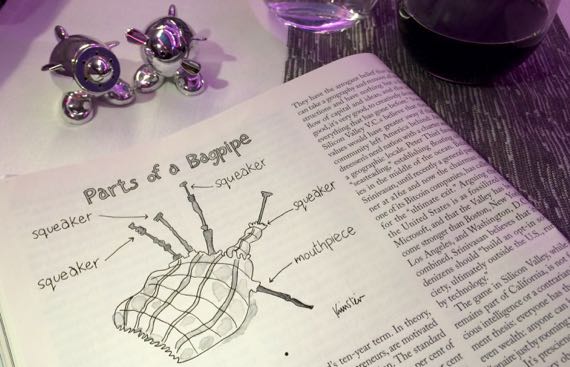
Ah, high-flying style for cocktail hour…love those wee chubby airplane salt-and-pepper shakers!

Sometimes the sun comes up and you have a new outlook on the world. Sometimes the sun comes up and you are in a new place.
We had some of both today.

Deflated amusement park….
By day’s end, we had slogged through miles of rain (in “Bono,” which has the license licence plate BNO), and found ourselves in a holiday and fishing-fleet town (that’s diversity!) where nearly no one was out and about—too wet; too windy; have to get up early to go fishing…. Until the sky began to turn blue and the puddles began to dry up…then we saw dog-walkers and exercisers…and a few locals getting from here to there….
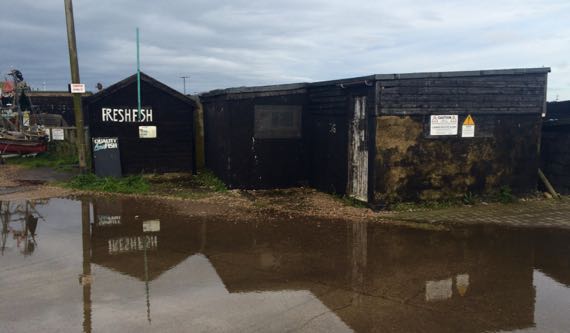
Long day! But fruitful….
Posted at 2:40 PM |
1 Comment »

Awful news out of Nepal, v.2.
Awful news of Amtrak/Philly.
We watched some of it on Skynews. Not Skye news.
Posted at 2:03 PM |
2 Comments »

Looks like the insects have found the green tomatoes…is this worse than the squirrels finding them…and carting them off???
Posted at 4:25 PM |
Comments Off on Host (or insectarium?)




































